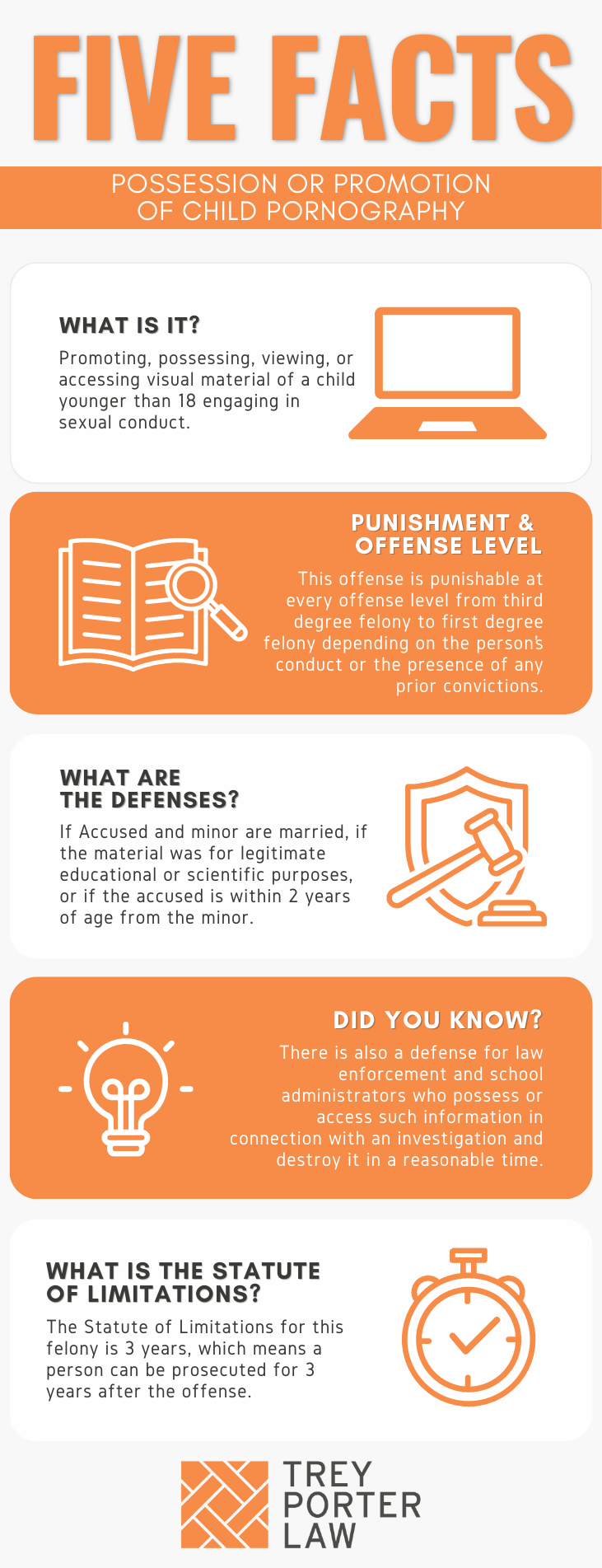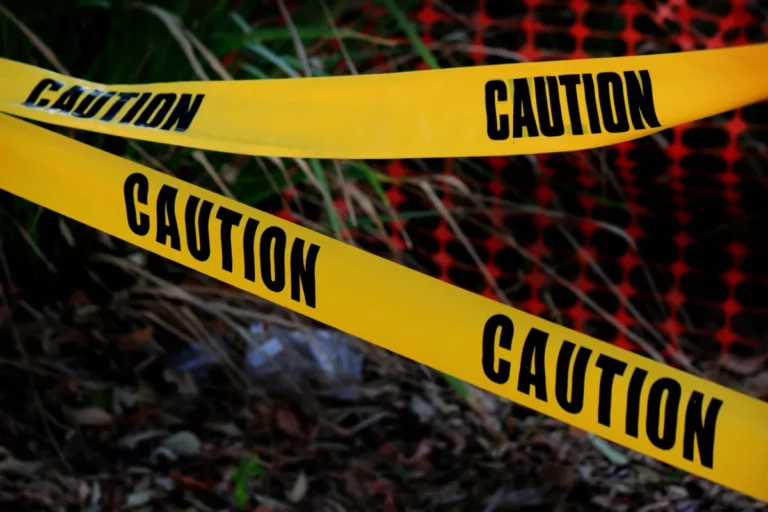WHAT IS POSSESSION OR PROMOTION OF CHILD PORNOGRAPHY IN TEXAS?
The Texas law against possession or promotion of child pornography prohibits possessing, promoting, viewing, or accessing visual material depicting a child younger than 18 years of age engaging in sexual conduct.
- What is sexual conduct? Texas Penal Code Section 43.25 defines “sexual conduct” as sexual contact, sexual intercourse, deviate sexual intercourse (oral sex), bestiality, masturbation, sado-masochistic abuse, or lewd exhibition of the genitals, anus, or the female nipple.

WHAT IS THE POSSESSION OR PROMOTION OF CHILD PORNOGRAPHY LAW IN TEXAS?
Tex. Penal Code § 43.26. POSSESSION OR PROMOTION OF CHILD PORNOGRAPHY.
(a) A person commits an offense if:
(1) the person knowingly or intentionally possesses, or knowingly or intentionally accesses with intent to view, visual material that visually depicts a child younger than 18 years of age at the time the image of the child was made who is engaging in sexual conduct, including a child who engages in sexual conduct as a victim of an offense under Section 20A.02(a)(5), (6), (7), or (8); and
(2) the person knows that the material depicts the child as described by Subdivision (1).
(c) The affirmative defenses provided by Section 43.25(f) also apply to a prosecution under this section.
(d) An offense under Subsection (a) is a felony of the third degree, except that the offense is:
(1) a felony of the second degree if it is shown on the trial of the offense that the person has been previously convicted one time of an offense under that subsection; and
(2) a felony of the first degree if it is shown on the trial of the offense that the person has been previously convicted two or more times of an offense under that subsection.
(e) A person commits an offense if:
(1) the person knowingly or intentionally promotes or possesses with intent to promote material described by Subsection (a)(1); and
(2) the person knows that the material depicts the child as described by Subsection (a)(1).
(f) A person who possesses visual material that contains six or more identical visual depictions of a child as described by Subsection (a)(1) is presumed to possess the material with the intent to promote the material.
(g) An offense under Subsection (e) is a felony of the second degree, except that the offense is a felony of the first degree if it is shown on the trial of the offense that the person has been previously convicted of an offense under that subsection.
(h) It is a defense to prosecution under Subsection (a) or (e) that the actor is a law enforcement officer or a school administrator who:
(1) possessed or accessed the visual material in good faith solely as a result of an allegation of a violation of Section 43.261;
(2) allowed other law enforcement or school administrative personnel to possess or access the material only as appropriate based on the allegation described by Subdivision (1); and
(3) took reasonable steps to destroy the material within an appropriate period following the allegation described by Subdivision (1).
WHAT IS THE PENALTY CLASS FOR POSSESSION OR PROMOTION OF CHILD PORNOGRAPHY IN TEXAS?
The penalty classification for possessing or promoting child pornography depends on the person’s conduct, and whether the accused has prior convictions for child pornography.
- Third degree felony, punishable by two to ten years in prison, if the person possesses or accesses with intent to view visual material depicting a child under 18 engaging in sexual conduct;
- Second degree felony, punishable by two to 20 years in prison, if the person:
- possesses or accesses with intent to view visual material depicting a child under 18 engaging in sexual conduct, and has one prior conviction for the same offense; or
- promotes or possesses with intent to promote visual material depicting a child under 18 engaging in sexual conduct;
- First degree felony, punishable by five to 99 years or life in prison, if the person:
- possesses or accesses with intent to view visual material depicting a child under 18 engaging in sexual conduct, and has two prior convictions for the same offense; or
- promotes or possesses with intent to promote visual material depicting a child under 18 engaging in sexual conduct.
WHAT IS THE PUNISHMENT RANGE FOR POSSESSION OR PROMOTION OF CHILD PORNOGRAPHY IN TEXAS?
The punishment range for possession or promotion of child pornography corresponds to the penalty classification, which depends on the person’s conduct, and prior convictions.
- First degree felony: five to 99 years or life in prison, maximum $10,000 fine;
- Second degree felony: two to 20 years in prison, maximum $10,000 fine;
- Third degree felony: two to ten years in prison, maximum $10,000 fine.
WHAT ARE THE PENALTIES FOR POSSESSION OR PROMOTION OF CHILD PORNOGRAPHY IN TEXAS?
A person charged with possession or promotion of child pornography may be eligible for probation after a conviction, or deferred adjudication without a conviction, for a period not to exceed ten years.
- Does possession or promotion of child pornography require registration as a sex offender in Texas? Yes. Possession or promotion of child pornography is a reportable adjudication or conviction included in the Sex Offender Registration Program, so a person convicted or placed on deferred adjudication will be required to register as a sex offender.
WHAT ARE THE DEFENSES TO POSSESSION OR PROMOTION OF CHILD PORNOGRAPHY IN TEXAS?
The statute authorizes three affirmative defenses to possession or promotion of child pornography: (1) the accused was the spouse of the child at the time of the offense; (2) the conduct was for a bona fide educational, medical, psychological, psychiatric, judicial, law enforcement, or legislative purpose; or (3) the accused is not more than two years older than the child.
The statute creates a specific defense for law enforcement and school administrators who were in possession of or accessed child pornography in good faith, solely as a result of an allegation of electronic transmission of visual material depicting a minor, and took reasonable steps to destroy the material within an appropriate period after the allegation.
WHAT IS THE STATUTE OF LIMITATIONS FORPOSSESSION OR PROMOTION OF CHILD PORNOGRAPHY IN TEXAS?
The limitation period for possession or promotion of child pornography is three years.
POSSESSION OR PROMOTION OF CHILD PORNOGRAPHY IN TEXAS
Texas criminalizes possession or promotion of child pornography, which punishes possessing, accessing, and promoting all images depicting children in a manner designed to elicit a sexual response from pedophiles.
TEXAS POSSESSION OR PROMOTION OF CHILD PORNOGRAPHY COURT CASES
The case law regarding possession or promotion of child pornography in Texas explains that even the manipulation of an image already made can constitute an offense.
- In State v. Bolles, the defendant was using a computer at a public library. He photographed a reproduced image of Robert Mapplethorpe’s photo, Rosie, which depicted a young female child in a dress but no underwear. The defendant zoomed in on the visible portion of the child’s vagina, and was convicted of possessing child pornography.The appellate court affirmed. Although the image was originally a work of art, the defendant created a new image depicting the lewd exhibition of the female child’s genitals when he zoomed in on her vagina and cropped the rest.
- In Romo v. State, the defendant was convicted of possession of child pornography based on a purported French nudist documentary depicting young naked girls competing in a beauty pageant. The defendant argued on appeal the girls are not engaged in sexual activity, and the film is artistic expression.After a thorough review of the video and its contents, the appellate court disagreed. While the video is not what one would normally think of as child pornography, because there were no sex acts, close-ups of genitals, and it was not overtly nasty, it nevertheless is designed to elicit a sexual response in a pedophile.
















